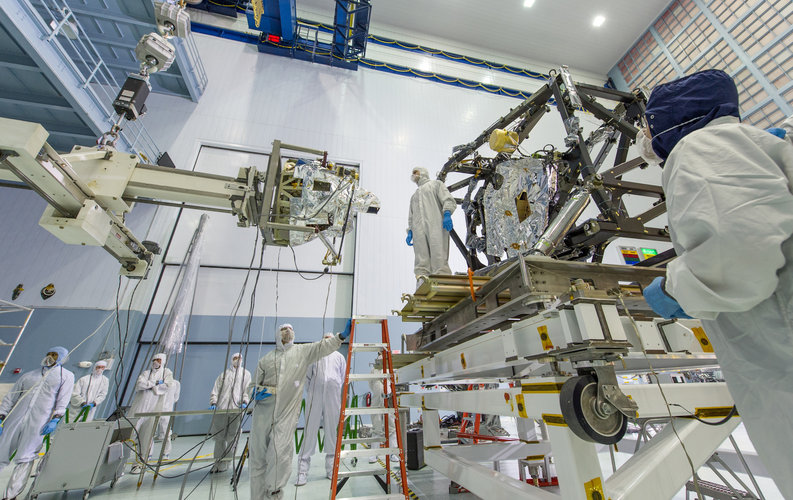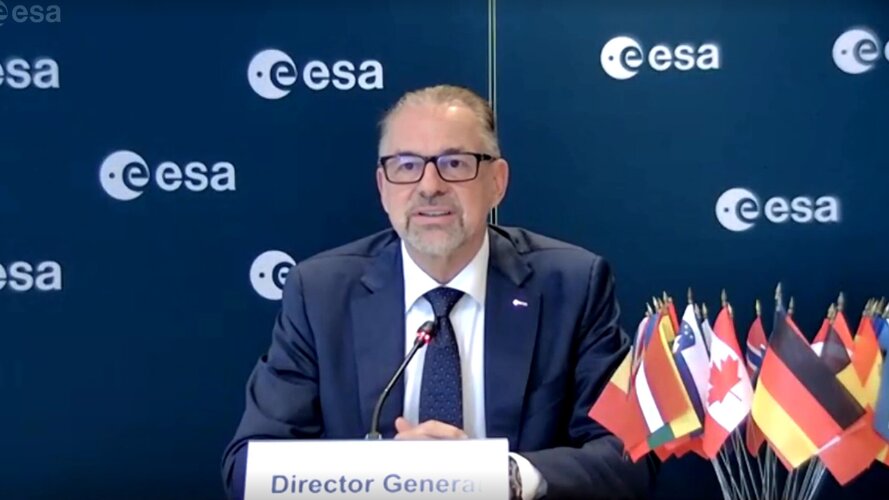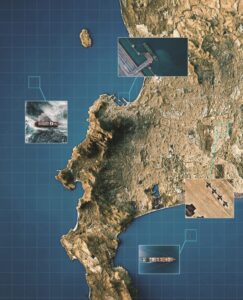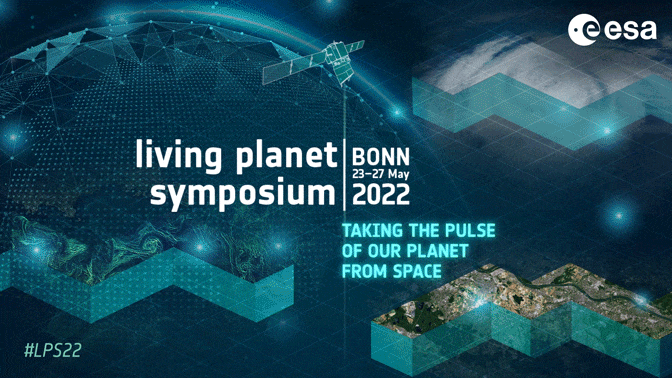Image: Axiom Mission 1 at Pad 39A and Artemis I at Pad 39B
Wednesday, 13 April 2022 14:07
Axiom Mission 1 (Ax-1) is in the foreground on Launch Pad 39A with NASA's Artemis I in the background on Launch Pad 39B on April 6, 2022.
This is the first time two totally different types of rockets and spacecraft designed to carry humans are on the sister pads at the same time—but it won't be the last as NASA's Kennedy Space Center in Florida continues to grow as a multi-user spaceport to launch both government and commercial rockets.
Ax-1 liftoff is scheduled at 11:17 a.m. EDT Friday, April 8, from Launch Complex 39A at NASA's Kennedy Space Center in Florida.
Explore further
Webb’s coldest instrument reaches operating temperature
Wednesday, 13 April 2022 14:00
With help from a cryocooler, Webb's Mid-Infrared Instrument has dropped down to just a few degrees above the lowest temperature matter can reach and is ready for calibration.
Media session - ESA Council extraordinary meeting
Wednesday, 13 April 2022 14:00 Video:
01:15:00
Video:
01:15:00
ESA Director General Josef Aschbacher shares the outcome of the ESA Council extraordinary meeting in this virtual Q&A with journalists. Additional updates are provided on ESA’s main programmes, the overall rollout of Agenda 2025 on the way to the ESA Ministerial Meeting in November 2022 as well as further implications of the current geopolitical situation on ESA’s activities.
Image: The largest antenna ever tested in ESA's Hertz radio frequency test chamber
Wednesday, 13 April 2022 13:31
The largest antenna ever tested in ESA's Hertz radio frequency test chamber is this 5-m diameter transponder antenna, which will operate down on the ground to help calibrate the Biomass mission, which will chart all the forests on Earth.
"This is a particularly challenging test campaign both in terms of the size of the antenna and the very low P-band frequency that Biomass will be using, which allows it to pierce through forest canopies to acquire individual trees," explains ESA antenna engineer Luis Rolo, overseeing the test campaign.
"Usually when we test a large satellite here, its antenna is significantly smaller, typically between 0.5 and 2 meters across. But this entire structure is a radiating antenna in its own right, its sides coming near to the chamber walls.
"What this means is that the testing process highlight some aspects of the chamber we've never seen before, even after many years of testing. But we've come up with a measurement method involving multiple acquisitions from different spots within the chamber, combined carefully to subtract such environmental effects, yielding very accurate results.
Tiny but precise: Team creates compact device to help spaceships land safely on planets
Wednesday, 13 April 2022 13:20
A NASA-funded team led by SMU researchers think that their small, lightweight device developed to measure spaceship velocity will improve the odds of successful landings on Mars and other planets.
Smaller, they say, is better in space.
The optical microresonator built by the team is only 2 millimeters in length, compared to the velocity-monitoring tool most commonly used on spacecraft—the Fabry-Perot interferometer—which can be as long as 500 millimeters. NASA and other space agencies may be able to use the microresonator to get an accurate, quick measurement of how fast a spaceship is moving in a specific direction.
Op-ed | The future of geointelligence is about information dominance, not data
Wednesday, 13 April 2022 13:00
The war in Ukraine has put the importance of information dominance on full display.
The post Op-ed | The future of geointelligence is about information dominance, not data appeared first on SpaceNews.
Register for Living Planet Symposium 2022
Wednesday, 13 April 2022 10:50
Register for Living Planet Symposium 2022
White House releases in-space servicing strategy
Wednesday, 13 April 2022 10:36
A new federal strategy seeks to coordinate activities among agencies and interaction with the private sector to advance work making and repairing spacecraft in space.
The post White House releases in-space servicing strategy appeared first on SpaceNews.
Rocket Lab Breaks Ground on Neutron Production Complex in Wallops, Virginia
Wednesday, 13 April 2022 09:21 Rocket Lab USA, Inc (Nasdaq: RKLB) today broke ground on the construction of a state-of-the-art rocket production complex where the Company's Neutron launch vehicle will be manufactured.
The 250,000 square foot Neutron Production Complex is being constructed on a 28-acre site adjacent to the NASA Wallops Flight Facility and Mid-Atlantic Regional Spaceport on Virginia's Eastern Shore. The c
Rocket Lab USA, Inc (Nasdaq: RKLB) today broke ground on the construction of a state-of-the-art rocket production complex where the Company's Neutron launch vehicle will be manufactured.
The 250,000 square foot Neutron Production Complex is being constructed on a 28-acre site adjacent to the NASA Wallops Flight Facility and Mid-Atlantic Regional Spaceport on Virginia's Eastern Shore. The c Elon Musk urges cadet researchers to keep innovating, make rocket launches 'boring'
Wednesday, 13 April 2022 09:21 SpaceX CEO Elon Musk motivated cadets at the U.S. Air Force Academy to keep the research industry on its toes by fighting complacency and working overtime to break boundaries.
"We want to take the fiction out of science fiction," Musk told throngs of cadets during his April 7 stopover at the school as featured speaker for the Ira C. Eaker Lecture, named to honor U.S. Army Air Force General
SpaceX CEO Elon Musk motivated cadets at the U.S. Air Force Academy to keep the research industry on its toes by fighting complacency and working overtime to break boundaries.
"We want to take the fiction out of science fiction," Musk told throngs of cadets during his April 7 stopover at the school as featured speaker for the Ira C. Eaker Lecture, named to honor U.S. Army Air Force General Space Perspective unveils luxurious balloon-launched spaceflight experience
Wednesday, 13 April 2022 09:21 Want to be a space tourist but can't spend tens of millions of dollars?
Space Perspective, a Florida-based space tourism company, is working on another option that falls in the six-figure range.
On Tuesday, the company provided a sneak peek into the luxurious $125,000-per-ride accommodations its passengers will enjoy as they stare down Earth from a vantage point that has mostly b
Want to be a space tourist but can't spend tens of millions of dollars?
Space Perspective, a Florida-based space tourism company, is working on another option that falls in the six-figure range.
On Tuesday, the company provided a sneak peek into the luxurious $125,000-per-ride accommodations its passengers will enjoy as they stare down Earth from a vantage point that has mostly b AFRL completes series of 1 newton ascent monopropellant thruster testing
Wednesday, 13 April 2022 09:21 The Chemical Propulsion Flight Programs Group at the Air Force Research Laboratory has successfully completed the Advanced Spacecraft Energetic Non-toxic Propellant (ASCENT) monopropellant 1 Newton (1N) thruster testing in the Chemical in-Space Thruster Test and Research Site test facility.
"This work is important to the U.S. Space Force since it provides satellites with propulsive capab
The Chemical Propulsion Flight Programs Group at the Air Force Research Laboratory has successfully completed the Advanced Spacecraft Energetic Non-toxic Propellant (ASCENT) monopropellant 1 Newton (1N) thruster testing in the Chemical in-Space Thruster Test and Research Site test facility.
"This work is important to the U.S. Space Force since it provides satellites with propulsive capab A water-rich world in the inner solar system-that isn't Earth
Wednesday, 13 April 2022 09:21 Dwarf planet Ceres is becoming a new research focus in the recent field of ocean worlds science. It is the only large, water-rich body that has been characterized to an extraordinary level of detail thanks to NASA's Dawn mission. But what does all this research mean and where do we go from here?
In Ceres: An Ice-Rich World in the Inner Solar System, Drs. Li and Castillo-Rogez provide a tho
Dwarf planet Ceres is becoming a new research focus in the recent field of ocean worlds science. It is the only large, water-rich body that has been characterized to an extraordinary level of detail thanks to NASA's Dawn mission. But what does all this research mean and where do we go from here?
In Ceres: An Ice-Rich World in the Inner Solar System, Drs. Li and Castillo-Rogez provide a tho NASA and UAE to share Mars mission datasets
Wednesday, 13 April 2022 09:21 NASA's MAVEN mission and the United Arab Emirates' Hope Probe mission are paving the way toward greater scientific collaboration and data exchange between the two Mars orbiters.
A new partnership that encourages the sharing of data between NASA's MAVEN (Mars Atmosphere and Volatile Evolution) project and the Emirates Mars Mission's (EMM) Hope Probe will enhance scientific returns from both
NASA's MAVEN mission and the United Arab Emirates' Hope Probe mission are paving the way toward greater scientific collaboration and data exchange between the two Mars orbiters.
A new partnership that encourages the sharing of data between NASA's MAVEN (Mars Atmosphere and Volatile Evolution) project and the Emirates Mars Mission's (EMM) Hope Probe will enhance scientific returns from both New home for Earth's protectors
Wednesday, 13 April 2022 09:21 ESA's new Space Safety Centre is a hub for activities protecting our planet from a raging star, risky asteroids and defunct satellites.
ESA Director General Josef Aschbacher inaugurated the Centre today at the Agency's ESOC mission control centre, in Darmstadt, Germany.
Living close to an active star, in a Solar System filled with ancient and fast-moving asteroids, on a planet that i
ESA's new Space Safety Centre is a hub for activities protecting our planet from a raging star, risky asteroids and defunct satellites.
ESA Director General Josef Aschbacher inaugurated the Centre today at the Agency's ESOC mission control centre, in Darmstadt, Germany.
Living close to an active star, in a Solar System filled with ancient and fast-moving asteroids, on a planet that i 
